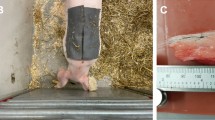Summary
An amperometric enzyme electrode and a wick technique were used for measurement of glucose in sc. tissue of sheep. When wicks were left implanted long enough to equilibrate with interstitial fluid, sc. glucose could have been reproducibly determined with the necessary accuracy. It was demonstrated that sc. tissue glucose concentrations in sheep are about 30% higher than in whole blood and are on the level of plasma glucose. This allows interpretation of sc. glucose sensor currents since results of in vitro-calibrations cannot be transferred to in vivo conditions. When an enzymatic sensor was implanted in the sc. compartment, the sensor signals were closely related to changes of blood glucose. These in vivo experiments indicate that short term glucose-monitoring with an subcutaneously implantable glucose sensor is feasible and so may provide a possible access to glycemic control.
Further experiments will have to show, if glucose-controlled insulin infusions based on the output of a sc. glucose sensor will be able to maintain stable normoglycemia.
Similar content being viewed by others
Abbreviations
- sc.:
-
subcutaneous
- iv.:
-
intravenous
- SEM:
-
standard error of means
- G:
-
gauge
- vs.:
-
versus
References
Aukland K, Fadnes HO (1982) Wick method for measuring interstitial fluid protein concentration. Acta phys scand 84:26A
Clark LC Jr, Duggan CA (1982) Implanted electroenzymatic glucose sensor. Diab Care 5:174–180
Fischer U, Ertle R, Abel P et al (1987) Assessment of subcutaneous glucose concentration: validation of the wick technique as a reference for implanted electrochemical sensors. Diabetologia 30:940–945
Guyton AC, Granger HJ, Taylor AE (1971) Interstitial fluid pressure. Phys Rev 51:527–563
Higgins PJ, Garlick RL, Bunn F (1982) Glycosylated hemoglobin in human and animal red blood cells: role of glucose permeability. Diabetes 31: 743–748
Kerner W, Zier H, Steinbach G et al (1987) Measurement of subcutaneous glucose concentration in sheep with an amperometric enzyme electrode. In: Schmidt RD (ed) Biosensors, Int. Workshop 1987, GBF Monographs Vol. 10
Kerner W, Zier H, Steinbach G, Brückel J et al (1989) A potentially implantable enzyme electrode for measurement of glucose. Horm Metab Res Suppl 20 (Reisensburg Conf 1987): 8–13
Kessler M, Höper J, Volkholz H-J et al (1984) A new glucose electrode for tissue measurements. Hepato-gastroenterol 31:285–287
Noddeland H (1982) Colloid osmotic pressure of human subcutaneous interstitial fluid sampled by nylon wicks: evaluation of the method. Scand J clin Lab Invest 42:123–130
Pfeiffer EF, Thum Ch, Clemens AH (1974) The artificial beta cell. A continuous control of blood sugar by external regulation of insulin infusion (glucose controlled insulin infusion system). Horm Metab Res 6:339–342
Shichiri M, Yamasaki Y, Kawamori R et al (1982) Wearable artificial endocrine pancreas with needle-type glucose sensor. Lancet 20:1129–1131
Shichiri M, Kawamori R, Hakui N et al (1984) Closed-loop glycemic control with a wearable artificial endocrine pancreas. Diabetes 33:1200–1202
Thevenot DR, Coulet PR, Sternberg R et al (1978) A highly sensitive glucose electrode using glucose oxidase collagen film. Bioelektrochem Bioenerg 5:548–553
Turner APF, Pickup JC (1985) Diabetes mellitus: Biosensors for research and management. Biosensors 1:85–115
Wolcott MW, Malinin T, Wu NM (1976) Changes in the interstitial fluid and the muscle water in rabbits in hemorrhagic shock. Ann Surg 184:728–733
Wolfson SK Jr, Tokarsky JF, Yao SJ et al (1982) Glucose concentrations at possible sensor tissue implant sites. Diab Care 5:162–165
Author information
Authors and Affiliations
Rights and permissions
About this article
Cite this article
Brückel, J., Kerner, W., Zier, H. et al. In vivo measurement of subcutaneous glucose concentrations with an enzymatic glucose sensor and a wick method. Klin Wochenschr 67, 491–495 (1989). https://doi.org/10.1007/BF01721675
Received:
Revised:
Accepted:
Issue Date:
DOI: https://doi.org/10.1007/BF01721675




